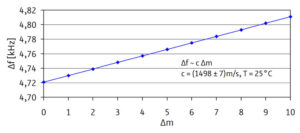PHY17 Acousto-Optical Modulation of Standing Ultrasonic Waves
Couldn't load pickup availability
Acousto-Optical Modulation of Standing Ultrasonic Waves
Investigation of the acousto-optical effect of amplitude and phase modulation of light diffracted by a standing ultrasonic wave
The acousto-optical effect of amplitude and phase modulation of light diffracted by a standing ultrasonic wave is investigated. The effect is used to determine the speed of sound in water.
Keywords: acousto-optical effect, standing ultrasonic wave, sound wavelength, diffraction, optical grating, grating constant, amplitude modulation, phase shift
According to the Debye-Sears effect (PHY11), light is diffracted by a standing or moving ultrasonic wave in a liquid or solid. The diffraction maxima generated by diffraction by a standing ultrasonic wave are amplitude modulated, with a phase shift of 180° occurring between the 0th and nth order maximum. This effect is used in acousto-optical modulators (AOM). Amplitude modulation and phase shift can be detected using photodiodes and an oscilloscope. A change in the sound frequency influences the modulation amplitude. The modulation amplitude is always greatest when the distance h between the ultrasonic transducer and the sound reflector corresponds to a multiple m of half the sound wavelength. This enables the speed of sound c in the medium to be determined according to c = 2 h Δf / Δm (Δf: frequency difference between maximum modulation amplitudes).
To determine the speed of sound in water, the 0th diffraction order is adjusted to a photodiode and a first maximum amplitude is sought. The sound frequency is then increased step by step and the frequencies of the following maximum amplitudes are determined. For the measurement points shown in the diagram, the speed of sound in water is (1498 ±7) m/s (T = 25 °C). To determine the phase shift, the laser beam is split using a beam splitter. The second partial beam is adjusted to a second photodiode so that it records another diffraction maximum. The phase shift between the two different diffraction orders can then be determined on the oscilloscope.
SCOPE OF DELIVERY:
| Item No. | Designation |
|---|---|
| 20100 | CW Generator SC600 |
| 20200 | Debye-Sears set |
| 20301 | Beam splitter |
| 20302 | 2 adjustable mirrors |
| 20303 | 2 photodiode receivers |
| – | Oscilloscope (not included, needed for the experiment) |
ADDITIONAL EXPERIMENTS:
| PHY11 | Debye-Sears effect |
| IND04 | Concentration measurement with resonance cell |




